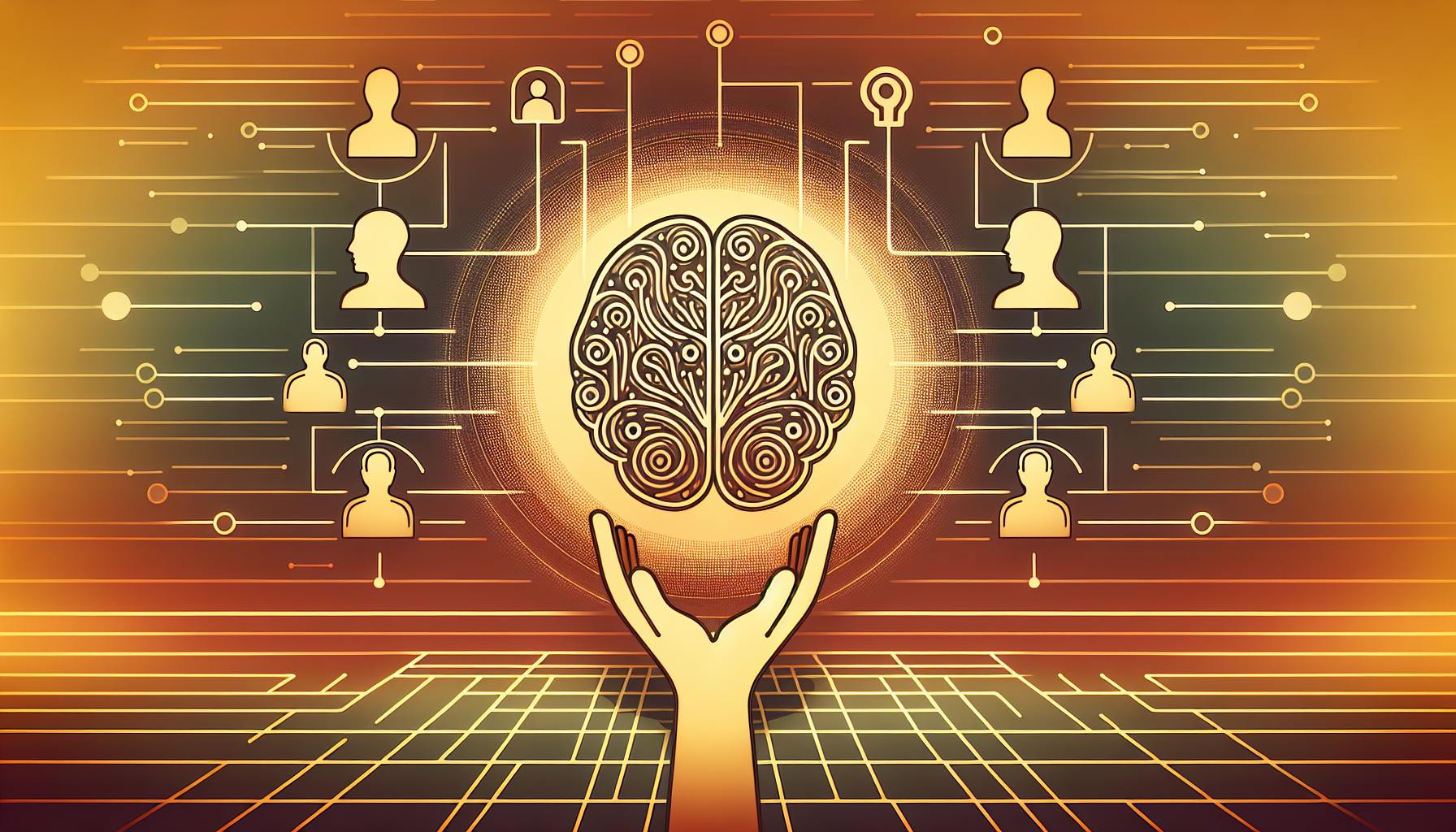Developing AI agents that can assist people is an admirable goal that most would support.
Integrating custom GPT models into AI agents can enhance their capabilities to better serve human needs.
This article explores the technical process of integrating custom GPTs into AI agents, the benefits this integration offers, and real-world applications that demonstrate the potential of AI agents empowered by GPT models to provide personalized support across industries.
Introduction to AI Agents and Custom GPT Integration
AI agents are software systems designed to perceive environments and take actions to achieve goals. Integrating custom GPT (Generative Pre-trained Transformer) models can enhance their natural language and reasoning capabilities.
Defining AI Agents and Their Role in Artificial Intelligence
AI agents include intelligent systems like:
- Software agents - operate autonomously to perform specific tasks
- Autonomous agents - perceive environments and make decisions without human oversight
- Intelligent agents - demonstrate problem-solving abilities
They play a key role in artificial intelligence by demonstrating capacities like reasoning, knowledge representation, planning, learning, perception, motion, manipulation, and interaction.
Advantages of Custom GPT Integration in AI Agents
Integrating large language models like GPT-3 brings many advantages:
- Improves language processing abilities
- Enables agents to understand and generate human-like text
- Allows "fine-tuning" models for better performance on specialized tasks
- Facilitates the development of more capable and flexible intelligent systems
Exploring the Synergy between AI Agents and OpenAI's GPT Models
OpenAI's GPT models excel at language tasks. Integrating them into AI agent architectures:
- Enhances natural language understanding and generation
- Provides more sophisticated text reasoning and summarization
- Allows agents to learn complex behaviors from natural language
This synergy leads to more capable agents.
The Evolution of AI Agents with Custom GPT Integration
The integration of custom GPT models marks a new evolution in AI agents - from simple, rules-based systems to sophisticated learning agents. As GPT capacities improve, agents gain:
- Increased autonomy through advanced reasoning and decision making
- Greater adaptability and knowledge acquisition from self-supervised learning
- More human-like communication and language understanding
This evolution promises more intelligent, capable AI agents.
What does an AI agent do?
AI agents are software programs that can perceive their environment, make decisions based on that input, and take actions accordingly. Here are some key things AI agents can do:
- Interact naturally with humans - AI agents like Siri, Alexa, and Google Assistant can understand natural language requests and respond appropriately through voice interfaces.
- Personalize experiences - AI agents can learn user preferences over time and customize services. For example, Netflix and Spotify recommend content based on viewing and listening habits.
- Automate tasks - AI agents can take over repetitive computer-based tasks, freeing up human time. Examples include scheduling meetings, filling out forms, or restocking inventory.
- Make data-driven decisions - AI agents can analyze large datasets and detect patterns to optimize decisions or make forecasts. Self-driving cars do this to navigate roads.
The key capabilities enabling AI agents to perform these tasks include machine learning, natural language processing, computer vision, and automation APIs. With the right data and algorithms, AI agents can keep improving and taking on more responsibilities.
As AI agent technology advances, we can expect them to become even more useful, personalized and autonomous. The custom integrations possible with systems like ChatGPT open up many possibilities for creating specialized AI agents tailored to specific industries and use cases.
What are the 5 types of agent in AI?
The five main types of intelligent agents in artificial intelligence include:
- Simple reflex agents: These agents select actions based on the current percept, ignoring the rest of the percept history. They are effective for simple environments but do not work well in complex environments.
- Model-based agents: These agents can handle partially observable environments. They maintain some sort of internal state to track aspects of the world that can't directly perceive. This allows them to choose actions based not just on the current percept but also on the history of percepts.
- Goal-based agents: These agents have explicit goal information and can choose actions that seem most likely to lead to achieving those goals. They are more flexible than simpler agents.
- Utility-based agents: These agents try to maximize their own "happiness", which is defined by a utility function that maps each state to a numeric value. They will learn a policy to maximize total reward.
- Learning agents: These agents can operate in unknown environments and improve their performance over time through trial and error. They learn from experience and interactions with the environment.
So in summary, as we move from simple reflex agents to learning agents, the agents become more sophisticated in their ability to handle complex and changing environments. The most advanced agents can set their own goals, maximize rewards, and improve policies over time.
Which is the best AI agent?
BRAiN is an excellent AI assistant that provides both real-time internet search capabilities and the ability to upload personal data for analysis. Here are some of the key benefits that make BRAiN a top AI agent option:
Ease of Use
BRAiN has an intuitive user interface that makes it simple for anyone to start using its AI capabilities right away. No coding or technical knowledge is required. You can easily ask questions, upload files, and access results.
Customizable Searches
BRAiN allows you to fine-tune searches to your specific needs. You can filter by date, source, file type, and more to get tailored results. This makes it more efficient than just using a standard search engine.
Analyzes Uploaded Data
A key advantage of BRAiN is that it can process and extract insights from your own uploaded data, including web pages, PDFs, documents, and more. This allows you to get custom analyses based on your unique data.
Continually Improving
As an AI agent, BRAiN continually learns and improves from new data and feedback. This means its capabilities and accuracy will only get better over time as it processes more information.
In summary, BRAiN is one of the top AI agents because of its versatile features, ease of use, and ability to keep improving. For both internet searches and analyzing personal data, BRAiN is an excellent choice.
Is ChatGPT an AI agent?
ChatGPT is indeed considered an AI agent. As the section context mentions, ChatGPT is an artificial intelligence chatbot that utilizes natural language processing to have conversations. Some key points:
- AI agents are software systems that can perceive environments and take actions to maximize their chance of success at some goal. ChatGPT fits this definition.
- ChatGPT demonstrates agency - it acts based on its internal states and drives to achieve outcomes. For example, it seeks to provide useful, harmless, and honest responses.
- It utilizes machine learning, specifically deep learning neural networks, to understand natural language and generate human-like responses. This advanced AI capability makes it an intelligent agent.
- ChatGPT was created by Anthropic, an AI safety startup, to be helpful, harmless, and honest. This aligns with goals for safe and ethical AI agents.
So in summary, ChatGPT is very much an AI agent - it leverages AI and machine learning to converse and assist users. Integrating custom AI models can further expand its capabilities as an intelligent agent.
sbb-itb-b2c5cf4
Selecting the Right GPT Model for Your AI Agent
When integrating a custom GPT model into an AI agent like ChatGPT, it's important to select the right model for your specific needs. Here are some key considerations:
Task-Specific GPT Models vs. General AI Agents
- Fine-tuned GPT models that are trained on data related to a specific task or industry will often outperform general purpose models for that particular task. For example, a GPT model fine-tuned on legal documents would be better for a legal AI assistant than a general ChatGPT model.
- However, general AI agents like ChatGPT have the benefit of being able to understand and respond to a very wide range of topics and questions. This makes them useful as general assistants.
So consider whether you need an AI agent specialized for a certain task, or one with broad capabilities.
Evaluating GPT Model Quality for AI Agents Integration
When selecting a custom GPT to integrate, evaluate model quality metrics including:
- Perplexity - How well the model predicts sample text, lower is better.
- Accuracy - Percentage of correct predictions on a test set.
- F1 Score - Balance of precision and recall on generating text.
- Human Evaluation - Real users rating responses for accuracy, coherence, etc.
Also test how well the model responds to sample queries and ensures it maintains context appropriately.
Compatibility Between AI Agent Capabilities and GPT Models
Ensure the NLP capabilities of your AI agent platform can fully leverage the strengths of the GPT model:
- ChatGPT offers advanced conversational context, so integrate with a GPT optimized for long-form responses.
- Consider model size - larger models have more knowledge but may exceed platform limits.
- Match model training data characteristics to intended use case.
Tuning between the model and agent is key.
Implications of Reinforcement Learning in GPT Model Selection
Reinforcement learning allows models to improve through dynamic feedback.
Consider if the custom GPT can continue training:
- Will the model learn from user interactions?
- Can it request feedback to correct mistakes?
- Does the agent allow passing updated parameters back to the model?
This enables the AI agent to evolve and specialize over time. Carefully evaluate model and agent capabilities in this regard.
Technical Guide to Integrating GPT Models into AI Agents
Integrating custom GPT models into AI agents like ChatGPT can enhance functionality and allow for more specialized applications. Here is a technical guide to walk through the process.
Utilizing LangChain and AI Agents Plugins for GPT Integration
Tools like LangChain and AI Agents plugins make integrating GPT models smooth and simple. LangChain provides a unified interface to manage fine-tuned models, while plugins handle deployment directly into ChatGPT.
To get started:
- Sign up for LangChain and create a fine-tuned GPT model for your needs.
- Install the LangChain or AI Agents plugin for your ChatGPT frontend.
- Configure the plugin to point to your LangChain model.
With just a few clicks, your custom GPT will be integrated and ready to use!
Setting Configuration and Parameters for Optimal Integration
Proper configuration is key for successful GPT model integration. Here are some key parameters:
- Temperature: Controls randomness - lower values make responses more deterministic.
- Frequency penalty: Reduces repetitive responses.
- Presence penalty: Encourages model to generate more words.
Start with the default values, then tweak parameters incrementally based on model performance. Measure coherence, consistency, and accuracy to guide optimization.
Testing and Iteration: Ensuring AI Agents' Performance
Rigorously test integrated models to ensure optimal AI agent performance. Establish benchmarks, then methodically evaluate responses across diverse prompts.
Assess where the model falters - does it hallucinate facts? Avoid questions? Provide irrelevant responses? Refine the model through further fine-tuning iterations to address weak points.
Testing and refinement is crucial to ensure custom integrations meet performance standards over extended use. Architect rigorous test plans to catch issues early.
HyperWrite Assistant: A Case Study in Custom GPT Integration
HyperWrite Assistant demonstrates effective real-world integration of a custom GPT model. It focuses specifically on business writing assistance.
The developers fine-tuned a GPT variant with business emails, reports, and other documents. This allows HyperWrite to provide context-aware writing suggestions tuned to business use cases.
By specializing the foundation model for a narrow domain, HyperWrite Assistant delivers more relevant, higher quality responses. This drives user satisfaction and engagement.
The integration process also utilized extensive testing to ensure coherent, useful output across diverse writing tasks. This refinement was key to providing a reliable AI writing assistant suitable for enterprise use.
HyperWrite Assistant shows how disciplined fine-tuning and testing enables customized GPT integrations that enhance ChatGPT capabilities.
Enhancing AI Agent Performance with Custom GPT Models
Integrating custom GPT models can significantly enhance AI agent performance. As AI agents utilize neural networks and machine learning to complete tasks, leveraging the latest GPT architectures allows them to tap into more advanced natural language processing capabilities.
Scaling Compute Resources for AI Agents
As AI agents take on more complex responsibilities, their compute resource requirements increase. Cloud computing offers convenient scalability to ensure agent responsiveness even during peak usage. Best practices include:
- Provisioning auto-scaling groups to handle fluctuations in traffic
- Load balancing requests across multiple agent instances
- Upgrading to virtual machine types with more vCPUs and memory
By leveraging flexible cloud infrastructure, AI agents can take full advantage of integrated GPT models without performance degradation.
Monitoring AI Agents' Usage and Performance Metrics
Careful monitoring provides visibility into how custom GPT models are impacting AI agent effectiveness. Key metrics to track include:
- Request throughput
- Request latency
- Memory utilization
- Model accuracy
- User satisfaction ratings
Capturing this data over time reveals opportunities to fine-tune model training or resource allocation. This maximizes the business value delivered by AI agents.
Continuous Model Training for AI Agents' Growth
As AI agents gain more experience, their integrated GPT models can be further trained on new data. This additional learning enables agents to handle emerging queries and tasks more effectively over time.
Regular model tuning should focus on:
- Incorporating the latest real-world user conversations
- Expanding knowledge of industry terminology
- Refining responses to common questions
With continuous training, AI agents leveraging GPT models can achieve increasing autonomy.
AgentGPT: An Example of Ongoing GPT Model Improvement
The AgentGPT model demonstrates the benefits of ongoing enhancement for AI assistants. By consuming up-to-date dialog data, AgentGPT has learned to converse more naturally. It can also integrate its responses with external APIs to access expanded information.
As GPT architectures and model training techniques advance, integrations like AgentGPT will allow AI agents to inherit cutting-edge capabilities. This empowers them to deliver ever-higher business value through improved task completion.
Real-World Applications of AI Agents with Custom GPT Integration
AI agents integrated with custom GPT models open up many possibilities for practical real-world applications. By enhancing AI agents like ChatGPT with specialized knowledge and skills, businesses and individuals can harness the power of large language models for customized solutions.
Enhancing Customer Support with AI Agents ChatGPT
Integrating conversational AI into customer support interactions has demonstrated value for improving efficiency and resolution rates. However, general-purpose models like ChatGPT have limitations in domain-specific conversations.
By fine-tuning GPT models on customer support dialogues and integrating them into AI agents, the agents can provide more accurate, helpful responses. This leads to faster issue resolution, greater customer satisfaction, and reduced human support burden.
For example, an e-commerce company could train a GPT model on their product catalog and common customer issues. Integrating this into a customer-facing AI agent allows the agent to immediately understand customer problems and provide tailored solutions.
Creative Writing Boosted by AI Agents and GPT Models
Fiction writing is an area where AI generation shows much promise. However, current AI story writing tools lack coherent narrative and thematic flow.
Integrating GPT models fine-tuned on fiction corpora into AI writing assistants can provide authors with AI-generated prose suggestions. The AI agent focuses on style continuation and narrative development rather than grammar or spelling.
This allows writers to boost their creative throughput. The AI agent handles basic prose generation while the author directs plot trajectories and final edits.
AI Agents in Healthcare: Custom GPT for Medical Assistance
Healthcare AI assistants like chatbots promise more accessible medical advice. However, these agents struggle with accurately interpreting health inquiries without specific medical training.
Integrating GPT models fine-tuned on medical textbooks and journals can enable AI agents to intelligently discuss symptoms, diagnose conditions, and provide health guidance.
Such medically-focused AI agents can help patients understand their conditions while allowing human medical professionals to focus on critical cases. The integration of domain expertise makes such assistants more helpful for common medical questions.
Educational AI Agents: Personalized Learning with GPT
Current AI tutors lack adaptability in their teaching methods and content. By integrating GPT models fine-tuned on pedagogical best practices, AI education agents can offer personalized and adaptive learning.
For example, a GPT model could be trained on mathematics textbooks and common student misconceptions. Integrating this into an AI homework assistant allows it to generate problems tailored to each student's knowledge gaps.
As students work through these personalized exercises and assignments, the agent adapts its GPT-generated content to reinforce concepts students struggle with. This creates a customized learning experience not possible otherwise.
Conclusion: The Future of AI Agents with Custom GPT Integration
Recap of Custom GPT Integration Benefits in AI Agents
Integrating custom GPT models into AI agents provides significant benefits, including:
- Enhanced capabilities: Custom GPTs allow AI agents to handle more complex queries and perform specialized tasks they previously struggled with.
- Increased accuracy: Fine-tuned models provide more accurate responses for niche topics.
- Personalization: Users can create GPTs tailored to their unique needs.
- Efficiency: Specialized agents minimize the need for training multiple models.
- Scalability: As new GPT models emerge, they can be integrated to continuously improve the agent.
Looking Ahead: The Evolution of AI Agents and GPT Models
As artificial intelligence continues advancing rapidly, we can expect to see:
- More powerful GPTs released, leading to increasingly intelligent AI agents.
- New techniques for optimizing GPT training and integration.
- Emergence of customizable "GPT app stores".
- User-friendly platforms for building specialized GPTs without coding.
- Integration of multiple modalities like vision and speech within singular agents.
- GPT benchmarks focused on assessing real-world task competency.
- Regulations around responsible AI development and use.
With diligent, ethical efforts focused on human benefit, the future looks bright for more capable and trustworthy AI agents enhanced by GPT integration.


